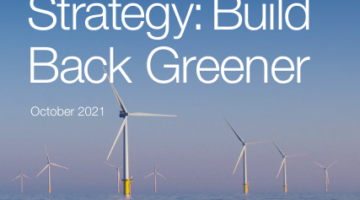
Solar advancements
Solar power isn’t new, solar power is the source of life itself. From growing our food to lighting our homes, humans have been harnessing solar power in one way or another for millenia. What is new, however, is the ways in which we’re harnessing it now. Solar panels are now commonplace around the world; the Obama administration installed panels on the White House back in 2010 and here in the UK about _ of our energy is produced from solar energy. At the moment they’re easily recognisable, looking like larger versions of the little panels you find on calculators, but all that is beginning to change.
Imagine a world in which every window harnesses energy, in which every windscreen helps power the car, in which your mobile starts charging itself whenever it’s in direct sunlight. That’s the vision of Michigan State University, who have been working for years on making transparent solar panels feasible. In the U.S. alone there are an estimated 5 billion to 7 billion square meters of glass surface that could be capturing and converting solar energy. That’s a lot of potential power. At the moment we’re still in the development stages of making the technology economically and logistically viable, but the signs are exciting.
There’s also a big push on using space-based solar panels in the very near future. That, however, is far too cool and science fictiony to fit in to this short space – you’ll have to wait for the dedicated blog.
 Smart homes
Smart homes
I am the biggest fan of old school 70’s spy films. You know the ones, where they end up stranded in a ski lodge somewhere with a bearskin rug and a scantily clad lady – cue clapper lights and an instart roaring fire. 30 years ago this was the height of Cool Technology, but in the year 2018 we have far surpassed this level of Cool when it comes to our homes. From smart thermostats that learn your schedule and heat your home in anticipation of how warm you like it, to lightbulbs that know to turn on when it’s dark outside, to heating hardware that can tell whether or not your windows are open. We are living in the future! In my humble abode, I use my Nest thermostat to turn my heating on when I leave the office so that the place is warm when I get in. I also use my Alexa to control my lights – I can simply ask her to put the bathroom light on at 30% brightness and I’m all ready for a long bath. If by any chance I’ve forgotten to turn my TV off at the plug before I turn in for the night, I have a timer controlled gadget to automatically cut the electricity to my television and games console after a set time to stop the standby zapping energy all night. These technologies are changing the way we use and think about energy, and creating a much more energy-conscious environment. Long live the smart home (and bring back clapper lights).
Fuel cells
The popular misconception here is that fuel cells are just another type of battery. Batteries are to fuel cells what cheesestring is to camembert (I’m writing this just before lunch). Given access to hydrogen and oxygen, a fuel cell can generate energy indefinitely (or for as long as the component parts last, which is a really long time given that there are no moving parts). It’s a technology that uses fossil fuels to produce electricity without burning up the hydrogen – or other fuel – that powers them. If you want an example of future tech that we’re already using today, this is it. Here in London we’ve already started using hydrogen fuel cell buses.
Actually, on the topic of energy saving tech in vehicles…
Electric cars
It may not seem wildly new given that the first electric car was created in the 19th century, but electric cars have come a long way. These days we have a variety of different electric and hybrid options. We’ve made a lot of progress in the past few years – there are around 125,000 plug-in vehicles on the roads in the UK today compared with just 3,500 in 2013. They produce no tailpipe emissions and require much less maintenance than traditional combustion engines, as they have significantly fewer moving parts. Innovations in recent years have lead to improved charging facilities, technological advancement, and a better public image.
Advancements are plentiful. There are projects are underway at the moment exploring the viability of using car batteries for battery storage, which would work a bit like a storage heater, charging up with energy at off-peak hours (when it’s cheaper) and then releasing it back in to the house when you actually need it. Meanwhile, Toyota is working with Panasonic Corp on energy-dense solid-state batteries, which could be a huge leap in electric battery tech.
Electric cars are taking over and the rate at which it’s happening is finally picking up.
Carbon capture
Carbon capture is the concept of collecting carbon pollutants at the point of production. If you can grab the harmful output before it has a chance to reach the atmosphere, you can the redirect where it goes. This is a massively important opportunity to slow and even halt climate change. If we can find a way to use fossil fuels without the negative effects of the carbon and pollutants, it means that we can continue to use these resources without damaging the earth (other than dilapidating our limited supplies.)
It’s been fairly standard practice for a few years now to pump the captured carbon in to chambers deep in the earth, which has actually worked surprisingly well. However, if there’s one thing I learned from GCSE science it’s that gas is particularly tricksy. In its gaseous form the carbon is prone to being absorbed by the porous rocks and passed up to the surface where it will eventually be released in the atmosphere anyway. This means that there’s a risk that all we’re doing is slowing down the process and buying ourselves some time before letting the gas back out to ravage the precious ozone anyway.
Enter stage left: some clever Icelandic scientists. They seperated out the carbon dioxide and dissolved it in water to form an acid. This is then pumped into basalt volcanic rock and over time combines and configures to create elements like limestone. The effectiveness of this, and similar other experiments has led to a series of breakthroughs in carbon capture technology. About 6 months ago the world’s first “negative emissions” plant opened in Iceland. At the moment it’s still in pilot stages, but it’s a significant step forward. The next decade of research will be all about refining the process and creating something that is economically feasible.
Think we missed something? Do you have a different opinion?
Comment below to get your voice heard…












No Comments yet! Be the first one.